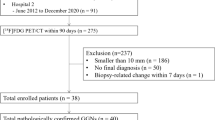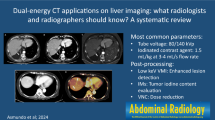Abstract
Purpose
To ascertain the performance of dual-energy CT (DECT) with iodine quantification in differentiating malignant mediastinal and hilar lymph nodes (LNs) from benign ones, focusing on patients with lung adenocarcinoma.
Materials and methods
In this study, patients with suspected lung cancer received a preoperative contrast-enhanced DECT scan from Jun 2018 to Dec 2020. Quantitative DECT parameters and the size were compared between metastatic and benign LNs. Their diagnostic performances were analyzed by the ROC curves and compared by using the two-sample t test.
Results
72 patients (23 men, 49 women; mean age 62.5 ± 10.1 years) fulfilled the inclusion criteria. A total of 98 LNs (67 benign, 31 metastatic) were analyzed. The iodine concentration normalized by muscle (NICmuscle) was significantly higher (P < 0.001) in metastatic LNs (4.79 ± 1.70) than in benign ones (3.00 ± 1.45). The optimal threshold of NICmuscle was 3.44, which yielded AUC: 0.798, sensitivity: 83.9%, specificity: 73.1%, accuracy: 76.5%, respectively. Applying the established size parameters with 10 mm as the threshold yielded AUC: 0.600, sensitivity: 29.0%, specificity: 91.0%, accuracy: 71.4%, respectively. The diagnostic performance of NICmuscle was significantly better (P = 0.007) than the performance obtained using the established size parameters.
Conclusions
For lung adenocarcinoma, the quantitative measurement of NICmuscle derived from DECT is useful for differentiating benign and metastatic mediastinal and hilar LNs before surgical intervention.




Similar content being viewed by others
Data Availability
The datasets used and/or analyzed during the current study are available from the corresponding author on reasonable request.
References
Bade BC, Dela Cruz CS. Lung cancer 2020: epidemiology, etiology, and prevention. Clin Chest Med. 2020;41(1):1–24.
Sharma A, Fidias P, Hayman LA, Loomis SL, Taber KH, Aquino SL. Patterns of lymphadenopathy in thoracic malignancies. Radiographics. 2004;24(2):419–34.
Silvestri GA, Gould MK, Margolis ML, Tanoue LT, McCrory D, Toloza E, et al. Noninvasive staging of non-small cell lung cancer: ACCP evidenced-based clinical practice guidelines (2nd edition). Chest. 2007;132(3 Suppl):178s–201s.
de Langen AJ, Raijmakers P, Riphagen I, Paul MA, Hoekstra OS. The size of mediastinal lymph nodes and its relation with metastatic involvement: a meta-analysis. Eur J Cardiothorac Surg. 2006;29(1):26–9.
Schmidt-Hansen M, Baldwin DR, Hasler E, Zamora J, Abraira V, Roqué IFM. PET-CT for assessing mediastinal lymph node involvement in patients with suspected resectable non-small cell lung cancer. Cochrane Database Syst Rev. 2014;2014(11):Cd009519.
Farjah F, Flum DR, Ramsey SD, Heagerty PJ, Symons RG, Wood DE. Multi-modality mediastinal staging for lung cancer among medicare beneficiaries. J Thorac Oncol. 2009;4(3):355–63.
Sánchez-Montalvá A, Barios M, Salvador F, Villar A, Tórtola T, Molina-Morant D, et al. Usefulness of FDG PET/CT in the management of tuberculosis. PLoS ONE. 2019;14(8): e0221516.
Siegel MJ, Kaza RK, Bolus DN, Boll DT, Rofsky NM, De Cecco CN, et al. White paper of the society of computed body tomography and magnetic resonance on dual-energy CT, part 1: technology and terminology. J Comput Assist Tomogr. 2016;40(6):841–5.
Patino M, Prochowski A, Agrawal MD, Simeone FJ, Gupta R, Hahn PF, et al. Material separation using dual-energy CT: current and emerging applications. Radiographics. 2016;36(4):1087–105.
Liu X, Ouyang D, Li H, Zhang R, Lv Y, Yang A, et al. Papillary thyroid cancer: dual-energy spectral CT quantitative parameters for preoperative diagnosis of metastasis to the cervical lymph nodes. Radiology. 2015;275(1):167–76.
Zhang X, Zheng C, Yang Z, Cheng Z, Deng H, Chen M, et al. Axillary sentinel lymph nodes in breast cancer: quantitative evaluation at dual-energy CT. Radiology. 2018;289(2):337–46.
Yang Z, Zhang X, Fang M, Li G, Duan X, Mao J, et al. Preoperative diagnosis of regional lymph node metastasis of colorectal cancer with quantitative parameters from dual-energy CT. AJR Am J Roentgenol. 2019;213(1):W17-w25.
González-Pérez V, Arana E, Barrios M, Bartrés A, Cruz J, Montero R, et al. Differentiation of benign and malignant lung lesions: dual-energy computed tomography findings. Eur J Radiol. 2016;85(10):1765–72.
Li Q, Li X, Li XY, He XQ, Chu ZG, Luo TY. Histological subtypes of solid-dominant invasive lung adenocarcinoma: differentiation using dual-energy spectral CT. Clin Radiol. 2021;76(1):77.e1-e7.
Li X, Meng X, Ye Z. Iodine quantification to characterize primary lesions, metastatic and non-metastatic lymph nodes in lung cancers by dual energy computed tomography: an initial experience. Eur J Radiol. 2016;85(6):1219–23.
Rizzo S, Radice D, Femia M, De Marco P, Origgi D, Preda L, et al. Metastatic and non-metastatic lymph nodes: quantification and different distribution of iodine uptake assessed by dual-energy CT. Eur Radiol. 2018;28(2):760–9.
Baxa J, Vondráková A, Matoušková T, Růžičková O, Schmidt B, Flohr T, et al. Dual-phase dual-energy CT in patients with lung cancer: assessment of the additional value of iodine quantification in lymph node therapy response. Eur Radiol. 2014;24(8):1981–8.
Wang BY, Huang JY, Chen HC, Lin CH, Lin SH, Hung WH, et al. The comparison between adenocarcinoma and squamous cell carcinoma in lung cancer patients. J Cancer Res Clin Oncol. 2020;146(1):43–52.
Cheng TY, Cramb SM, Baade PD, Youlden DR, Nwogu C, Reid ME. The international epidemiology of lung cancer: latest trends, disparities, and tumor characteristics. J Thorac Oncol. 2016;11(10):1653–71.
Ettinger DS, Wood DE, Aisner DL, Akerley W, Bauman J, Chirieac LR, et al. Non-small cell lung cancer, Version 5. 2017, NCCN clinical practice guidelines in oncology. J Natl Compr Canc Netw. 2017;15(4):504–35.
Yue JY, Chen J, Zhou FM, Hu Y, Li MX, Wu QW, et al. CT-pathologic correlation in lung adenocarcinoma and squamous cell carcinoma. Medicine (Baltimore). 2018;97(50): e13362.
El-Sherief AH, Lau CT, Wu CC, Drake RL, Abbott GF, Rice TW. International association for the study of lung cancer (IASLC) lymph node map: radiologic review with CT illustration. Radiographics. 2014;34(6):1680–91.
Yang Y, Li K, Sun D, Yu J, Cai Z, Cao Y, et al. Invasive pulmonary adenocarcinomas versus preinvasive lesions appearing as pure ground-glass nodules: differentiation using enhanced dual-source dual-energy CT. AJR Am J Roentgenol. 2019;213(3):W114–22.
Koo TK, Li MY. A guideline of selecting and reporting intraclass correlation coefficients for reliability research. J Chiropr Med. 2016;15(2):155–63.
Goldstraw P, Chansky K, Crowley J, Rami-Porta R, Asamura H, Eberhardt WE, et al. The IASLC lung cancer staging project: proposals for revision of the TNM stage groupings in the forthcoming (Eighth) edition of the TNM classification for lung cancer. J Thorac Oncol. 2016;11(1):39–51.
Ichinose J, Kohno T, Fujimori S, Harano T, Suzuki S, Fujii T. Invasiveness and malignant potential of pulmonary lesions presenting as pure ground-glass opacities. Ann Thorac Cardiovasc Surg. 2014;20(5):347–52.
Wang YW, Chen CJ, Huang HC, Wang TC, Chen HM, Shih JY, et al. Dual energy CT image prediction on primary tumor of lung cancer for nodal metastasis using deep learning. Comput Med Imaging Graph. 2021;91: 101935.
Euler A, Solomon J, Mazurowski MA, Samei E, Nelson RC. How accurate and precise are CT based measurements of iodine concentration? A comparison of the minimum detectable concentration difference among single source and dual source dual energy CT in a phantom study. Eur Radiol. 2019;29(4):2069–78.
Zhang XF, Lu Q, Wu LM, Zou AH, Hua XL, Xu JR. Quantitative iodine-based material decomposition images with spectral CT imaging for differentiating prostatic carcinoma from benign prostatic hyperplasia. Acad Radiol. 2013;20(8):947–56.
Gong HX, Zhang KB, Wu LM, Baigorri BF, Yin Y, Geng XC, et al. Dual energy spectral CT imaging for colorectal cancer grading: a preliminary study. PLoS ONE. 2016;11(2): e0147756.
Hussaini SA, Andola SK, Mahanta A. Study of metastasis in lymphnode biopsies with special reference to Immunohistochemistry (IHC) in metastatic breast carcinoma. J Clin Diagn Res. 2015;9(3):Ec13–6.
Aki R, Amoh Y, Bouvet M, Katsuoka K, Hoffman RM. Color-coded fluorescence imaging of lymph-node metastasis, angiogenesis, and its drug-induced inhibition. J Cell Biochem. 2014;115(3):457–63.
Yang F, Dong J, Wang X, Fu X, Zhang T. Non-small cell lung cancer: Spectral computed tomography quantitative parameters for preoperative diagnosis of metastatic lymph nodes. Eur J Radiol. 2017;89:129–35.
Yazdani S, Miki Y, Tamaki K, Ono K, Iwabuchi E, Abe K, et al. Proliferation and maturation of intratumoral blood vessels in non-small cell lung cancer. Hum Pathol. 2013;44(8):1586–96.
Dagnon K, Heudes D, Bernaudin JF, Callard P. Computerized morphometric analysis of microvasculature in non-small cell lung carcinoma. Microvasc Res. 2008;75(1):112–8.
Aoki M, Takai Y, Narita Y, Hirose K, Sato M, Akimoto H, et al. Correlation between tumor size and blood volume in lung tumors: a prospective study on dual-energy gemstone spectral CT imaging. J Radiat Res. 2014;55(5):917–23.
Nagano H, Takumi K, Nakajo M, Fukukura Y, Kumagae Y, Jinguji M, et al. Dual-energy CT-derived electron density for diagnosing metastatic mediastinal lymph nodes in non-small cell lung cancer: comparison with conventional CT and FDG PET/CT findings. AJR Am J Roentgenol. 2022;218(1):66–74.
Acknowledgements
This study has received funding by Ministry of Science and Technology, Taiwan, R.O.C. 109-2221-E-002 -035 -MY3.
Funding
This study has received funding by Ministry of Science and Technology (MOST). 109-2221-E-002-035-MY3.
Author information
Authors and Affiliations
Contributions
Conceptualization: HCH, YSH, YCC, JYS, JSC, YCC, TCW. Data curation: HCH, YSH, YCC. Formal analysis: HCH, YSH, YCC. Funding acquisition: YCC, TCW. Investigation: HCH, YSH, YCC, JYS, JSC. Methodology: HCH, YSH, YCC, JYS, JSC. Project administration: HCH, YSH, YCC. Resources: JYS, JSC, YCC, TCW. Software: HCH, YSH, YCC, YCC, TCW. Supervision: YCC, TCW. Validation: YSH, YCC, JYS, JSC, YCC, TCW. Writing-original draft: HCH. Writing-review and editing: YSH, YCC, YCC, TCW. All authors read and approved the final manuscript.
Corresponding author
Ethics declarations
Conflict of interest
The authors declare that they have no competing interests. The authors have no relevant financial or non-financial interests to disclose.
Ethical approval
Our clinical study received institutional review board approval and was compliant with HIPAA requirements. The study was performed per the ethical standards as laid down in the 1964 Declaration of Helsinki.
Consent to participate
Written informed consent was obtained from all the study participants.
Consent for publication
Manuscript does not contain data from any individual person.
Additional information
Publisher's Note
Springer Nature remains neutral with regard to jurisdictional claims in published maps and institutional affiliations.
About this article
Cite this article
Huang, HC., Huang, YS., Chang, YC. et al. Dual-energy computed tomography for evaluating nodal staging in lung adenocarcinoma: correlation with surgical pathology. Jpn J Radiol 42, 468–475 (2024). https://doi.org/10.1007/s11604-023-01525-9
Received:
Accepted:
Published:
Issue Date:
DOI: https://doi.org/10.1007/s11604-023-01525-9




